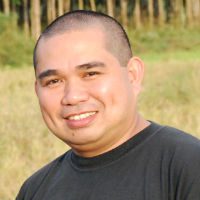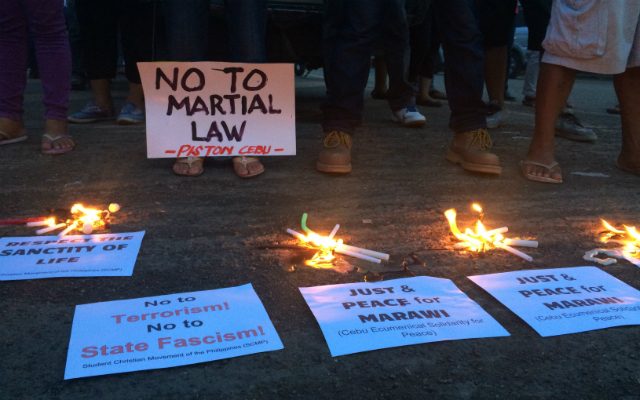SUMMARY
This is AI generated summarization, which may have errors. For context, always refer to the full article.

The declaration of Martial Law and the suspension of the writ of habeas corpus in Mindanao last May 23, 2017 by President Rodrigo Roa Duterte offers a quick respite from the armed disruption in Marawi with dire consequences on the lives of affected communities. Yet, for sure this declaration will worsen the Mindanao situation infected by social injustice.
The swift solution to address the Marawi crisis with an encompassing Martial Law in the whole of Mindanao creates a vacuum – a vacuum of uncertainty on whether violence or displacement will escalate, employing “military-solution” to the complex Mindanao problem.
There are calculable consequences of the Martial Law declaration: arrests, detention and death of personalities (especially those critical of the administration), increase in the number of internal refugees and displacement of communities in Mindanao and in other islands, and growing armed conflicts and social unrest due to militarization.
All these will result to a continued socio-political imbalance that directly and indirectly hinders integral economic growth affecting the government and ordinary Filipinos.
Ending the peace process
The search for a just and lasting peace is now put in the dustbin of history. The GRP panel just ended the peace talks with the NDFP at the height of discussing the implications of the ceasefire agreement in the areas of socioeconomics and political reforms. Another lost opportunity for a greater cause in solving the ills of social injustice in the whole country.
The impacts of the failed ceasefire agreement will ripple, growing rebellion affecting governance and the suffering of many Filipinos from poverty and war. And these will add to the growing imbalance of pro-people development in the whole of Mindanao, where the pseudo-development agenda of government sits on the throne of military power in the guise of imposing peace and order.
When peace becomes unreachable, the more Filipinos will suffer. A clear sign that President Duterte departed from his earlier position to pursue peace among rebel groups – for which many have seen the glaring pressure from his many military advisers now holding privileged positions in the government.
Since the president extended the call for peace early on his term to any rebel group, including even the Abu Sayyaf, why not continue the groundwork to make Mindanao free of violence and ultimately address the issues that breed rebellion?
Proof enough that at the very start, the government is not serious about the pursuit of a just and lasting peace, especially with the Communist Party of the Philippines (CPP) represented by the NDF. The many rounds of talks then, are only a stage-show of image-building.
“The civil and political rights of the people in Mindanao are gravely being curtailed and trampled on by the all-out attacks against the people. Hundreds of people are being rounded up. People are being detained or stopped from travelling for having no identification cards. The military are threatening people against issuing statements or posting information on social media that may be deemed anti-government. Military and bureaucrats have issued guidelines restricting people’s rights to assemble and prohibiting them from staging protest actions. A martial law crackdown hangs over the heads of social activists,” said the Communist Party of the Philippines in a statement.
Clear and present danger
The Mindanao bishops are still discerning on the moral compass of where this Martial Law is leading, aware of the complexity of the volatile situation of peace and order they are not totally engaging in a counter position with the government’s declaration.
But somehow, the collective statement of the Mindanao bishops offers a voice of caution: “Martial Law must be temporary…We shall condemn any abuse of Martial Law and as in the past will condemn it outright if it goes in the way of evil. Let us be vigilant.”
And also, the Presidents of Ateneo schools around the country in their joint statement offers a consoling call for continued vigilance: “We call on everyone to remain vigilant, to hold our officials accountable for their actions, to demand to know and to be told the truth at all times. We expect that the safeguards placed in our Constitution to curb the abuse of power will be respected and followed.” Both institutions call for peace and prayer for the victims and the whole of Mindanao.
If the Duterte government continues to deny the responsibility of the 8,000 drug-related killings under its watch, chances are it will also deny the future “excesses” of the current Martial Law in Mindanao.
During the anti-Martial Law mobilization along Fuente Osmeña in Cebu City, a protester holds a placard that reads “Martial Law = State Terrorism.” The declaration of Martial Law is at the threshold of abuses – human rights in nature. We cannot address the many armed conflicts solely with “military” considerations/ The whole web of complexity undermining the Philippine situation needs a grounded analysis that includes everyone – social, political, economic and even cultural.
Undeniably there is a growing support of the declaration from among his ardent supporters who remain supportive on his iconic call for change. Reminiscent of Marcos’ batas militar that early on its implementation ordinary Filipinos were made to believe that such declaration will do greater good for the country; justifying tooth-and-nail that the mass protests as the mask of rebellion. The rest is history of repression – colored with arrests, tortures and deaths.

According to the American historian, Alfred McCoy, the figure of the victims of Marcos’ Martial Law: “3,257 killed, an estimated 35,000 tortured, and some 70,000 arrested.” Marcos Martial Law should never be repeated. What difference will it be with Duterte’s? Duterte will either make or break the tyrannical record of Marcos.
Martial Law can never assure that there is no abuse of power in its scope. It will in fact embolden the excess of police and military powers – both proven in our Marcos experience and of the administration’s war on drugs. This in fact, is the clear and present danger.
Voices of discontent
The path that leads to the good of the Republic is following the Constitution. Even the declaration of Martial Law is clearly stipulated and more so the safeguards on how and why it should be implemented. President Duterte’s end game on his Martial Law declaration is his stubborn reluctance to hear the side of the law and will continue imposing Martial Law – clearly saying that he will only listen to the PNP and AFP, not to Congress and the Supreme Court.
Sadly, there are already glaring signs of ruthless insinuations on how Martial Law can be done on the ground – encouraging killings, raids, and even rape – from the mouth of the president himself.
There is a need to consolidate the growing voices of discontent, if there is still hope to immediately end this Martial Law, and move towards the original direction of sustaining inclusion of Muslims, Christians and non-believers (and of any Filipino) in integral development based on social justice. In the end, Martial Law is not the solution.
Our fear of Martial Law is not an act of unfairly judging President Rodrigo Roa Duterte, but rather a way of telling him not to fall into the trap of military calculation that leads to social miscalculations – moving him away from his consistent call for inclusive social change. – Rappler.com
Br. Tagoy Jakosalem, OAR, is a visual artist and sustainability educator. He studied philosophy, finished his theology in 1999, and has been active with the Climate Reality Project of Al Gore. He was instrumental in the formation of heartanonymous.org, an organization involved in holistic rehabilitation response to the families who survived in the aftermath of Typhoon Haiyan (Yolanda).
Add a comment
How does this make you feel?
There are no comments yet. Add your comment to start the conversation.